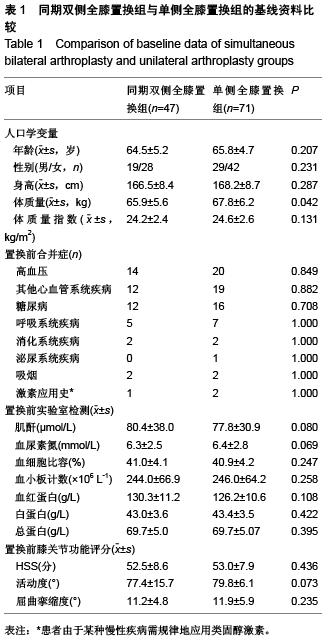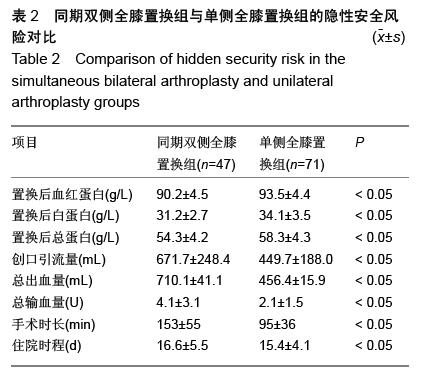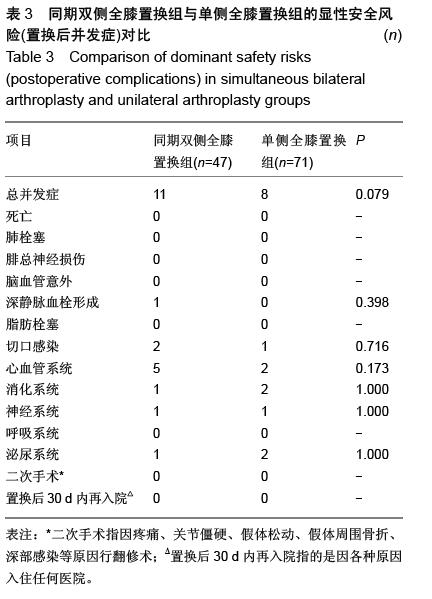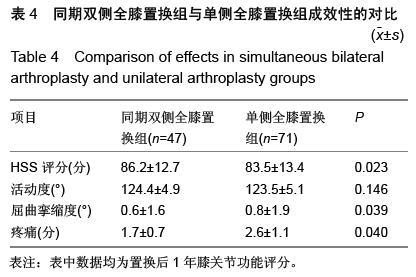| [1] Fu D, Li G, Chen K, et al. Comparison of clinical outcome between simultaneous-bilateral and staged-bilateral total knee arthroplasty: a systematic review of retrospective studies. J Arthroplasty. 2013; 28(7): 1141. [2] Rodriguez JA, Bhende H, Ranawat CS. Total condylar knee replacement: a 20-year followup study. Clin Orthop Relat Res. 2001; 388: 10. [3] Gill GS, Joshi AB, Mills DM. Total condylar knee arthroplasty. 16-to 21-year results. Clin Orthop Relat Res. 1999; 367: 210. [4] Thadani PJ, Vince KG, Ortaaslan SG, et al. Ten-to 12-year followup of the Insall-Burstein I total knee prosthesis. Clin Orthop Relat Res. 2000; 380:17. [5] Hootman JM, Helmick CG. Projections of US prevalence of arthritis and associated activity limitations. Arthritis Rheum. 2006; 54(1): 226. [6] Oakes DA, Hanssen AD. Bilateral total knee replacement using the same anesthetic is not justified by assessment of the risks. Clin Orthop Relat Res. 2004; 428: 87. [7] 陈百成,张静.骨关节炎[M].北京:人民卫生出版社, 2014. [8] Lombardi AV, Mallory TH, Fada RA, et al. Simultaneous bilateral total knee arthroplasties: who decides? Clin Orthop Relat Res. 2001; (392): 319-329. [9] Lynch NM, Trousdale RT, LIstrup DM. Complications after concomitant bilateral total knee arthroplasty in elderly patients. Mayo Clin Proc. 1997;72: 799-805. [10] Cram P, Lu X, Kates SL, et al. Total knee arthroplasty volume, utilization, and outcomes among Medical beneficiaries, 1991-2010. JAMA. 2012; 308(12): 1227. [11] Alvi HM, Mednick RE, Krishnan V, et al. The Effect of BMI on 30 Day Outcomes Following Total Joint Arthroplasty. J Arthroplasty. 2015. [12] Lane GJ, Hozack WJ, Shah S, et al. Simultaneous bilateral versus unilateral total knee arthroplasty: outcomes analysis. Clin Orthop Relat Res. 1997;345: 106-112. [13] Pavone V, Johnson T, Saulog PS, et al. Perioperative morbidity in bilateral one-stage total knee replacements. Clin Orthop Relat Res. 2004;421:155-161. [14] Bullock DP, Sporer SM, Shirreffs Jr TG. Comparison of simultaneous bilateral with unilateral total knee arthroplasty in terms of perioperative complications. J Bone Joint Surg. 2003;85(10):1981-1986. [15] Hutchinson JR, Parish EN, Cross MJ. A comparison of bilateral uncemented total knee arthroplasty? J Bone Joint Surg. 2006;88(1):40-43. [16] 陈德胜,李亚平,吕金捍,等.双侧人工全膝关节同期置换预存自体输血28例[J]. 临床医学,2009, 13(9):1769-1772. [17] Stefansdottir A, Lidgren L, Robertsson O. Higher early mortality with simultaneous rather than staged bilateral TKAS: results from the Swedish knee Arthroplasty Register. Clin Orthop Relat Res. 2008;466(12): 3066-3070. [18] Memtsoudis SG, Della Valle AG, Besculides MC, et al. In-hospital complications and mortality of unilateral, bilateral, and revision TKA: based on an estimate of 4,159,661 discharges. Clin Orthop Relat Res. 2008; 466(11): 2617-2627. [19] March LM, Cross M, Tribe KL, et al. Two knees or not two knees? Patient costs and outcomes following bilateral and unilateral total knee joint replacement surgery for OA11Source of Support: Grant funding from the National Health and Medical Research Council of Australia and the Woodend Foundation. Osteoarthrit Cartilage. 2004;12(5): 400-408. [20] Kim YH, Choi YW, Kim JS. Simultaneous bilateral sequential total knee replacement is as safe as unilateral total knee replacement. J Bone Joint Surg. 2009;91(1): 64-68. [21] Hooper GL, Hooper NM, Rothwell AG, et al. Bilateral total joint arthroplasty: the early results from the New Zealand National Joint Registry. J Arthroplasty. 2009; 24(8): 1174-1177. [22] Shin YH, Kim MH, Ko JS, et al. The safety of simultaneous bilateral versus unilateral total knee arthroplasty: the experience in a Korean hospital. Singapore Med J.2010;51(1):44-49. [23] Macario A, Schilling P, Rubio R, et al. Economics of one-stage versus two-stage bilateral total knee arthroplasties. Clin Orthop Relat Res. 2003;414: 149-156. [24] Chiu FY, Lin CF, Chen CM, et al. Cefuroxime-impregnated cement at primary total knee arthroplasty in diabetes mellitus. A prospective, randomised study. J Bone Joint Surg Br. 2001;83: 691-695. [25] Munjal S, Phillips MJ, Krackow KA. Revision total knee arthroplasty: planning, controversies, and management-infection. Instr Course Lect. 2001, 50: 367-377. [26] Lynch NM, Trousdale RT, Ilstrup DM. Complications after concomitant bilateral total knee arthroplasty in elderly patients [C] // Mayo Clinic Proceedings. Elsevier. 1997;72(9): 799-805. [27] Memtsoudis SG, Mantilla CB, Parvizi J, et al. Have bilateral total knee arthroplasties become safer? A population-based trend analysis. Clin Orthop Relat Res. 2013; 471(1): 17-25. [28] Memtsoudis SG, Ma Y, Chiu YL, et al. Bilateral total knee arthroplasty: risk factors for major morbidity and mortality. Anesth Analg. 2011; 113(4): 784-790. [29] Peskun C, Mayne I, Malempati H, et al. Cardiovascular disease predicts complications following bilateral total knee arthroplasty under a single anesthetic. Knee. 2012; 19(5): 580-584. [30] Lindberg-Larsen M, Jorgensen CC, Husted H, et al. Early morbidity after simultaneous and staged bilateral total knee arthroplasty. Knee Surg Traumatol Arthrosc. 2015; 23(3): 831. [31] NSQIP Data Collection, Analysis and Reporting. http://site. acsnsqip. org/program-specifics/data- collection-analysis-and-reporting/. [Accessed April 18 2014]. [32] 童培建,肖鲁伟,主编.人工关节置换术并发症防治及术后康复[M].北京:人民卫生出版社, 2005: 5. [33] Kurtz SM, Ong KL, Lau E, et al. Impact of the economic downturn on total joint replacement demand in the United States: updated projections to 2021. J Bone Joint Surg Am. 2014; 96(8): 624. [34] 王致华.同期双侧人工膝关节置换术后早期康复效果评价[J].临床心身疾病杂志,2009, 15(4):359. [35] 张延杰,郝军,高文香.同期双侧全膝关节置换与选择性单侧膝关节置换术后早期功能康复临床观察[J].中国医学创新,2013, 10(10):20-21. [36] Cao L, Ablimit N, Mamtimin A, et al. Comparison of no drain or with a drain after unilateral total knee arthroplasty: a prospective randomized controlled trial. Zhonghua Wai Ke Za Zhi. 2009;47(18): 1390-1393. |
.jpg)



